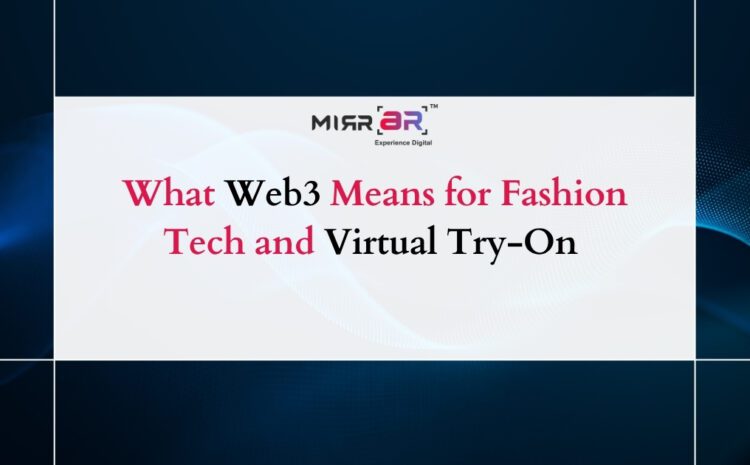The fashion industry is undergoing a seismic transformation, and one of the key forces behind this change is Web3. From decentralized ownership to immersive virtual experiences, Web3 is reshaping how consumers engage with fashion. Among the most exciting developments is the intersection of Web3 with Fashion Tech and Virtual Try-On (VTO) technology. These innovations promise not just enhanced shopping experiences but also a shift in how fashion is designed, owned, marketed, and worn in digital and physical spaces.
Understanding Web3: A New Era of the Internet
Web3 represents the third generation of internet technology, characterized by decentralization, blockchain, NFTs (non-fungible tokens), and smart contracts. Unlike Web2, where platforms control user data, Web3 empowers users with ownership and control. In the context of fashion, this means creators and consumers can interact more transparently and fairly, fostering a more inclusive and innovative environment.
Web3 doesn’t just affect how we use the internet—it redefines the very framework of digital identity, ownership, and commerce. For fashion tech, this evolution opens the door to more secure and engaging digital fashion experiences, including new business models, loyalty systems, and user-generated virtual wardrobes.
Digital Fashion: A Booming Web3 Frontier
One of the earliest and most impactful integrations of Web3 in fashion has been through digital fashion assets and NFTs. Brands are now creating clothing that exists only in the digital world—garments that can be purchased, traded, and even worn on avatars in virtual environments such as the metaverse.
These virtual garments are often minted as NFTs, ensuring ownership authenticity and rarity. For instance, a digital Gucci bag bought in a metaverse can be just as valuable—and sometimes more expensive—than a physical one. This new paradigm is not just about status; it’s about identity and expression in a digital-first world.
Moreover, NFT-based fashion can provide artists and designers with royalties through smart contracts, allowing them to earn each time their design is resold—something not possible in traditional fashion resale markets.
Virtual Try-On: Enhancing the Digital Shopping Experience
VTO technology has already changed how people shop for clothes online. It uses augmented reality (AR) and AI to allow customers to try on clothes virtually using their smartphone or computer. However, with Web3 integration, Virtual Try-On becomes more personalized, secure, and interoperable across platforms.
Imagine this scenario: a user tries on a jacket in a Web3-powered store using VTO. After purchasing the NFT version, they can wear the jacket on their avatar in different virtual worlds, such as Decentraland or Roblox, or showcase it in digital social settings. The same jacket could also unlock real-world perks like event access or discounts through token-gated systems.
Blockchain-backed identities ensure that users have full control over their digital wardrobe, which can be seamlessly connected to their profiles across the internet. This seamless experience across physical and digital spaces is one of the most exciting outcomes of merging VTO with Web3.
Fashion Tech Meets Interactivity and Ownership
Fashion brands embracing Web3 are also exploring gamification and co-creation. Consumers no longer remain passive buyers—they become participants and stakeholders. Through DAOs (Decentralized Autonomous Organizations), fashion lovers can vote on design choices, collection themes, or marketing campaigns.
This level of interactivity fosters stronger community engagement. Coupled with VTO, brands can create virtual fashion shows where users not only watch but participate—trying on designs virtually, purchasing them as NFTs, and using them in gaming or social platforms.
Ownership is key here. With blockchain, users truly own their digital fashion items. These are no longer just graphical filters; they are verifiable assets that can appreciate in value and be traded on secondary markets.
Sustainable and Ethical Impacts
Web3 and Virtual Try-On also align with the growing push for sustainable fashion. By digitizing fashion experiences, brands can significantly reduce the need for physical samples, mass production, and returns—all of which have high environmental costs.
Try-before-you-buy VTO reduces the number of returns caused by poor fit or misrepresentation online, while digital fashion altogether removes the need for physical materials. Furthermore, transparent blockchain systems can track a garment’s production journey, providing ethical insights to the consumer and reinforcing brand trust.
Challenges Ahead
Despite its promise, Web3 integration in fashion tech isn’t without challenges. Mass adoption is still in progress, and many consumers are unfamiliar with concepts like NFTs and wallets. User experience must be intuitive for the technology to become mainstream.
Moreover, interoperability between different virtual environments and platforms still has a long way to go. Brands will need to collaborate and invest in open standards for virtual assets and VTO systems to work across ecosystems.
Security and privacy are also critical concerns. Blockchain offers transparency, but users must also be educated on securing their wallets and data.
The Future of Fashion is Web3-Enabled
The future of fashion lies at the crossroads of technology, creativity, and community. Web3 is more than just a buzzword—it’s a transformation in how fashion is consumed, co-created, and shared. Virtual Try-On tech enhances this vision by offering immersive, engaging experiences that bridge the physical and digital worlds.
Fashion brands that embrace these technologies early are not only future-proofing their business but also redefining the customer journey. With ownership, identity, sustainability, and personalization at the core, Web3 is enabling a bold, decentralized, and deeply interactive fashion future.
Are you ready to explore the next frontier of fashion? Whether you’re a brand or a consumer, start integrating Web3 tools and Virtual Try-On technologies to stay ahead. The runway of the future is digital—don’t miss your moment to shine.
